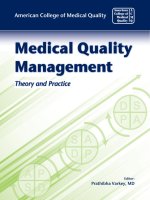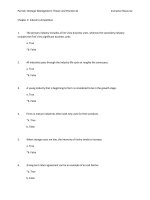MEDICAL QUALITY MANAGEMENT THEORY AND PRACTICE potx
Bạn đang xem bản rút gọn của tài liệu. Xem và tải ngay bản đầy đủ của tài liệu tại đây (1.28 MB, 254 trang )
A
P
S
D
A
P
S
D
AP
AP
SD
SD
American College of Medical Quality
Medical Quality
Management
Theory and Practice
Editor:
Prathibha Varkey, MD
American College of Medical Quality
Medical Quality
Management
Theory and Practice
Medical Quality Management
Theory and Practice
Editor:
Prathibha Varkey, MD
Jones and Bartlett Publishers
40 Tall Pine Drive
Sudbury, MA 01776
978-443-5000
www.jbpub.com
Jones
and
Bartlett
This new comprehensive resource addresses the needs of physicians, medical students, and
other health care professionals for current information about medical quality management.
This text provides a concise summary of utilization management including general approaches
and methods, support systems, regulatory constructs, and common outcomes. Medical
Quality Management: Theory and Practice is a necessary guide for all executives and medical
directors, academics, and students as well as for all physicians and other health professionals in
clinical practice.
Key Features
• Includes key chapters on Patient Safety, Quality Measurement, and External QI
• Describes the current state of global networks and computing technologies
• Provides an overview of important legislation, regulations, and case laws
• Emphasizes the importance of continually evaluating cost-quality interactions as a basis
for improving performance, budgeting, and policymaking by health care organizations
• Focuses on the application of medical ethics
• Includes case studies, executive summaries, learning objectives, and many fi gures
and tables
Visit us online! www.jbpub.com/healthprofessions
MEDICAL QUALITY
MANAGEMENT
THEORY AND PRACTICE
American College of Medical Quality
Editor: Prathibha Varkey
60342_FMxx_Final 1/12/09 8:19 PM Page i
World Headquarters
Jones and Bartlett Publishers
40 Tall Pine Drive
Sudbury, MA 01776
978-443-5000
www.jbpub.com
Jones and Bartlett Publishers
Canada
6339 Ormindale Way
Mississauga, Ontario L5V 1J2
Canada
Jones and Bartlett Publishers
International
Barb House, Barb Mews
London W6 7PA
United Kingdom
Jones and Bartlett’s books and products are available through most bookstores and online booksellers. To contact
Jones and Bartlett Publishers directly, call 800-832-0034, fax 978-443-8000, or visit our website www.jbpub.com.
Substantial discounts on bulk quantities of Jones and Bartlett’s publications are available to corporations,
professional associations, and other qualified organizations. For details and specific discount information,
contact the special sales department at Jones and Bartlett via the above contact information or send an email
to
Copyright © 2010 by Jones and Bartlett Publishers, LLC, and American College of Medical Quality
All rights reserved. No part of the material protected by this copyright may be reproduced or utilized in any form,
electronic or mechanical, including photocopying, recording, or by any information storage and retrieval system,
without written permission from the copyright owner.
The authors, editor, and publisher have made every effort to provide accurate information. However, they are
not responsible for errors, omissions, or for any outcomes related to the use of the contents of this book and take
no responsibility for the use of the products and procedures described. Treatments and side effects described in
this book may not be applicable to all people; likewise, some people may require a dose or experience a side effect
that is not described herein. Drugs and medical devices are discussed that may have limited availability
controlled by the Food and Drug Administration (FDA) for use only in a research study or clinical trial.
Research, clinical practice, and government regulations often change the accepted standard in this field. When
consideration is being given to use of any drug in the clinical setting, the health care provider or reader is
responsible for determining FDA status of the drug, reading the package insert, and reviewing prescribing
information for the most up-to-date recommendations on dose, precautions, and contraindications, and
determining the appropriate usage for the product. This is especially important in the case of drugs that are new
or seldom used.
Library of Congress Cataloging-in-Publication Data
Medical quality management : theory and practice / American College of Medical Quality. — 2nd ed.
p. ; cm.
Rev. ed. of: Core curriculum for medical quality management/American College of Medical Quality c2005.
Includes bibliographical references and index.
ISBN 978-0-7637-6034-2 (pbk. : alk. paper)
1. Medical care—United States—Quality control—Outlines, syllabi, etc. 2. Total quality management—
United States—Outlines, syllabi, etc. I. American College of Medical Quality. II. Core curriculum for
medical quality.
[DNLM: 1. Quality of Health Care—organization & administration. W 84.1 M4896 2009]
RA399.A3C667 2010
362.1068—dc22
2008048845
6048
Printed in the United States of America
13 12 11 10 09 10 9 8 7 6 5 4 3 2 1
Production Credits
Publisher: David Cella
Associate Editor: Maro Gartside
Production Manager: Julie Champagne Bolduc
Production Assistant: Jessica Steele Newfell
Senior Marketing Manager: Barb Bartoszek
Associate Marketing Manager: Lisa Gordon
Manufacturing and Inventory Control Supervisor:
Amy Bacus
Composition: Spearhead, Inc.
Cover Design: Timothy Dziewit
Printing and Binding: Malloy, Inc.
Cover Printing: Malloy, Inc.
60342_FMxx_Final 1/12/09 8:19 PM Page ii
Contents
Foreword xiii
Introduction xv
Contributors xix
Chapter 1 Basics of Quality Improvement 1
Prathibha Varkey, MD, MPH, MHPE
Executive Summary 1
The History of the Health Care Quality Management Movement:
Past to Present 2
The Purpose and Philosophy of Quality Management 5
Implementing a Quality Improvement Project 6
Tools for Quality Improvement 8
Process Mapping 8
Flow Charts 9
Cause-and-Effect (Fishbone) Diagram 9
Brainstorming and Affinity Diagrams 11
Pareto Chart 12
Histogram 13
Bar Chart 13
Scatter Diagram 16
Statistical Control Chart 16
Methods for Quality Improvement 16
Plan, Do, Study, Act (PDSA) Methodology 18
Six Sigma 20
Lean 21
iii
60342_FMxx_Final 1/12/09 8:19 PM Page iii
iv ■ Contents
Commonly Used Quality Improvement Strategies 22
Academic Detailing 22
Opinion Leaders 23
Audit and Feedback 23
Reminder Systems 23
Patient Education 23
Case Management 24
Reengineering 24
Incentives 24
Quality Improvement Research 24
Challenges to Successful Quality Improvement 25
Technology 25
Structure 25
Psychological Climate 25
Leadership 26
Culture 26
Legal Issues 26
Future Trends 26
References 27
Additional Resources–Further Reading 28
Chapter 2 Quality Measurement 29
Linda Harrington, PhD, RN, CNS, CPHQ, and
Harry Pigman, MD, MSHP
Executive Summary 29
History 29
Types of Quality Measures 30
Structural Measures 30
Process Measures 31
Outcome Measures 31
Constructing a Measurement 32
Baseline Measurement 32
Trending Measurements 32
Benchmarking 35
60342_FMxx_Final 1/12/09 8:19 PM Page iv
Contents ■ v
Desirable Characteristics of Quality Measurement 36
Relevance 37
Evidence-Based 37
Reliability or Reproducibility 37
Validity 37
Feasibility 37
Interpreting Quality Measures 37
Criterion-Based Measures 37
Opportunity Model 38
Program Evaluation 39
Formative Evaluations 39
Summative Evaluations 39
Future Trends 40
References 40
Chapter 3 Patient Safety 43
Philip J. Fracica, MD, MBA, FACP, Sharon Wilson, RN, BS, PMP,
and Lakshmi P. Chelluri, MD, MPH, CMQ
Executive Summary 43
History 44
Error as a Systems Issue 44
Human Factors as a Cause of Errors 48
Fatigue 48
Medication Errors 49
Common Risks to Patient Safety 55
Invasive Procedures 55
Infections 56
Patient Falls 57
Pressure (Decubitus) Ulcers 57
Patient Safety Tools 58
Tools for Data Acquisition 58
Analytic Tools 61
Retrospective Event Analysis 61
Pareto Charts 62
60342_FMxx_Final 1/12/09 8:19 PM Page v
vi ■ Contents
Fishbone Diagrams 62
Prospective Event Analysis 64
Disclosure of Errors 64
Prevention of Errors 65
Systems Approach 65
Operational Interventions to Prevent Error 66
Decision Support Systems 67
Teamwork and Crew Resource Management 68
High-Reliability Organizations (HROs) 68
Future Trends 70
References 70
Additional Resources–Further Reading 73
Chapter 4 Organization Design and Management 75
James T. Ziegenfuss, Jr., PhD, and
Thomas Biancaniello, MD, FACC
Executive Summary 75
History 76
Organizational Systems Thinking and Theories 76
1. Product and Technical Subsystem 76
2. Structural Subsystem 77
3. Psychosocial Subsystem 78
4. Managerial Subsystem 78
5. Organizational Culture 79
Responsibilities of a Leader in Quality Improvement 79
Advocacy and Spokesmanship 80
Policy, Planning, and Visioning 80
Delivery System Decision Support 80
Analysis and Control of Quality 80
External Liaison and Representation 80
Double Track 81
High-Performing Teams 82
Size and Structure 83
Shared Vision 83
Focused Objectives 83
60342_FMxx_Final 1/12/09 8:19 PM Page vi
Contents ■ vii
Leadership 83
Cohesion 83
Action 84
Follow-Up 84
Hoshin Planning 84
Learning Organizations 85
Knowledge Source: Internal–External 85
Product–Process Focus 85
Documentation Mode: Personal–Public 85
Dissemination Mode: Formal–Informal 85
Learning Focus: Incremental–Transformative 86
Value–Chain Focus: Design–Deliver 86
Skill Development Focus: Individual–Group 86
Future Trends 86
References 86
Additional Resources–Further Reading 88
Chapter 5 Medical Informatics 89
Louis H. Diamond, MB, ChB, FACP, and
Stephen T. Lawless, MD, MBA
Executive Summary 89
History: The Evolution of Medical Informatics in the United States 90
Essential Components of a Health Information Infrastructure 91
Data Sources 91
Data Definitions 92
Coding Classification Systems 92
Data Transmission 94
Health Information Exchange (HIE) 95
Data Storage 95
Data Analysis 96
Disease Staging 97
Electronic Medical Record (EMR) 98
Computerized Physician Order Entry (CPOE) 99
Decision Support Systems 100
EMR’s Impact on Quality and Safety 101
60342_FMxx_Final 1/12/09 8:19 PM Page vii
viii ■ Contents
Personal Health Record 103
Evaluating an Information Infrastructure 103
Barriers to Development of an Adequate Health
Information Infrastructure 104
Health Information Technology and Return on Investment 106
Future Trends 106
References 107
Additional Resources–Further Reading 108
HIT Standards (Abbreviated) 108
Chapter 6 Economics and Finance in Medical Quality Management 111
Donald Fetterolf, MD, MBA, FACP, and
Rahul K. Shah, MD, FAAP
Executive Summary 111
Historical Perspective 112
Basic Concepts in Business and Economics 113
Economics 113
Accounting 116
Finance 124
Other General Business Principles 125
Making the Business Case for Quality Management 128
Government Mandates 129
Demands by the Business Community 129
Requirements for Quality Oversight 129
Demands of Business Partners 129
Financial Effect 129
Trade-Off Between a Higher Accreditation Standard
and Lower Cost 130
Results of Estimates Using Mathematical Tools 130
Social Goals 130
Outcomes Categories 131
Pay-for-Performance (P4P) and Quality 136
Future Trends 140
References 141
Additional Resources–Further Reading 143
60342_FMxx_Final 1/12/09 8:19 PM Page viii
Contents ■ ix
Chapter 7 Utilization Management 145
Arthur L. Pelberg, MD, MPA
Executive Summary 145
History 145
Critical Components of Utilization Management Systems 146
The Utilization Management Process 147
The Nine Tasks Key to Effective Utilization Management 147
1. Determine Priority Areas 147
2. Identify Needed Information and Critical Stakeholders 147
3. Establish Appropriate Benchmarks 148
4. Design, Data Collection, and Data Management Procedures 148
5. Implement Data Collection and Management Procedures 148
6. Evaluate the Data and Present Results 148
7. Develop Guidelines, Policies, and Procedures 148
8. Implement Guidelines, Policies, and Procedures 148
9. Continuously Review the Task List 148
Processes, Procedures, and Timing of Utilization Management 149
Prior Authorization or Precertification 149
Concurrent Review and Discharge Planning 149
Retrospective Review 150
Interrater Reliability 150
Measuring the Effectiveness of UM Programs 150
Risk Management and Safety 152
Organizational Design of Utilization Management 152
Disease Management 152
Case Management 155
Care Plans 156
Demand Management 157
Peer Review 158
Credentialing 159
Criteria for Credentialing 160
Physician Profiles 160
Accreditation and Regulatory Oversight of Utilization Management 160
Models of Care 162
60342_FMxx_Final 1/12/09 8:19 PM Page ix
Chronic Care Model 162
Evidence-Based Medicine and Evidence-Based Management Model 163
Patient-Centered Medical Home Model 164
Future Trends 165
References 165
Additional Resources–Further Reading 166
Chapter 8 External Quality Improvement: Accreditation, Quality
Improvement Education, and Certification 167
Toni Kfuri, MD, MPH, CMQ, FACOG, and Nancy L. Davis, PhD
Executive Summary 167
History 168
Accreditation 170
National Committee for Quality Assurance 170
Utilization Review Accreditation Commission (URAC) 171
The Joint Commission 172
The Leapfrog Group 174
International Organization for Standardization (ISO) 174
Profiling 175
Healthcare Effectiveness Data and Information Set (HEDIS) 177
Baldrige 178
Public Reporting 184
Certification, Licensure, Credentialing 185
Teaching Quality Improvement 187
Undergraduate Medical Education 187
Graduate Medical Education 188
Continuing Medical Education 190
Future Trends 193
References 193
Additional Resources–Further Reading 195
Chapter 9 Interfaces Between Quality Improvement, Law, and
Medical Ethics 197
Jeffrey M. Zale, MD, MPH, CMQ, and Mano S. Selvan, PhD
Executive Summary 197
History 198
x
■ Contents
60342_FMxx_Final 1/12/09 8:19 PM Page x
Role of Government 199
Rules, Regulations, Laws, and Acts 199
Regulation and Public Laws to Ensure Quality 200
Health Care Quality Improvement Act and Peer Review Protection 201
The National Practitioner Data Bank 203
HIPAA and Its Multiple Titles 205
The Privacy Rule 206
The Transactions and Code Sets Rule 206
Facilitated Health Care Fraud and Abuse Investigation and Reporting 206
Medical Errors and Transparency 207
Basics of Malpractice 208
Facility–Organizational Risk Management Issues 211
Antitrust in Medicine 212
Alternative Dispute Resolution: Arbitration–Mediation 213
Ethics 215
Respect for Autonomy 215
Beneficence and Nonmaleficence 215
Justice 215
Human Subjects Research and QI 217
Institutional Review Boards 218
Future Trends 220
References 220
Additional Resources–Further Reading 222
Index 223
Contents
■ xi
60342_FMxx_Final 1/12/09 8:19 PM Page xi
60342_FMxx_Final 1/12/09 8:19 PM Page xii
xiii
Foreword
Carolyn M. Clancy, MD
Director, Agency for Healthcare Research and Quality (AHRQ)
Education is the most powerful weapon which you can use to change the world.
— Nelson Mandela
They say that time changes things, but you actually have to change them yourself.
— Andy Warhol
Only four years have passed since the book Core Curriculum for Medical Quality Management
was published in 2005. Since then, the field of quality improvement has seen major
progress in the impact of its research findings, the adoption of technology to promote
safety and enhance quality, and the dissemination of clinical and organizational case
studies.
Against this backdrop, the American College of Medical Quality has wisely decided to
issue this revised edition. As a physician and a director of a federal health research agency,
I am gratified to see both the faster pace of progress on quality improvement and the com-
mitment that this book makes to educate new and experienced health professionals.
Whether you have worked in quality improvement for 20 years or 20 days, I urge you to
thoroughly educate yourself on patient safety, to which an extensive chapter in this book
is devoted. As public and private sector policies evolve, the reputation, clinical excellence,
and financial success of your organization will depend greatly on patient safety outcomes.
A timely chapter on medical informatics is a comprehensive resource on standards and
data, state and national information systems, data sets and coding systems, and case
studies. Research projects on health information technology funded by my agency con-
tinue to underscore both the challenges of implementation and the tremendous oppor-
tunities for improved safety and quality.
60342_FMxx_Final 1/12/09 8:19 PM Page xiii
Topics that are the bread and butter of medical quality management—quality mea-
surement, utilization management, accreditation, education, and certification—receive a
thorough examination in this edition. They also benefit from the addition of new case
studies, which provide a valuable “real-world” element and a look at future trends.
The American College of Medical Quality continues to be a national leader in edu-
cating the medical community about both the science and the practice of medical quality
management. The new edition of this book underscores the College’s commitment to our
shared vision of a safer health care system and provides many resources to readers that will
guide our journey.
xiv
■ Foreword
60342_FMxx_Final 1/12/09 8:19 PM Page xiv
xv
Introduction
Alex R. Rodriguez, MD
Medical quality management is a term that has yet to find its way into any leading com-
pendium of health care definitions. Nevertheless, it represents an area in which almost all
physicians in active clinical practice are engaged on a daily basis as well as the primary
field of professional action for an estimated 16,000 physicians in the United States and an
unknown but growing number internationally. Medical quality management (MQM) is
elemental to clinical services and has been recognized as an area of medical specialization
by the American Medical Association for 20 years, but public recognition of the field
needs a strong boost.
While many health care professionals become engaged in MQM activities over the
course of their clinical careers, only a few have received any formal training or orientation
in the field during their undergraduate or postgraduate professional training. During
their formative training, medical and nursing students and residents may become aware
that some licensed professionals are involved in utilization review, quality improvement,
and risk management activities; however, few are aware of the rich scientific base and
health tradition that frames the field.
Dr. Avedis Donabedian initially termed the professional practice field clinical outcomes
management, which was later popularized by Dr. Paul Ellwood’s seminal 1988 Shattuck
Lecture published in the New England Journal of Medicine.
1,2
Since then, only two major
texts have provided summations of the essential components of MQM: Health Care Quality
Management for the 21st Century, edited by James Couch, MD, JD, and Core Curriculum for
Medical Quality Management, published by the American College of Medical Quality
(ACMQ), the latter of which provides the most recent compendium of the elemental
knowledge base for the field of MQM.
3,4
Medical Quality Management: Theory and Practice has been written and edited as a basic
text to describe the key components of MQM. As such, this text has applicability for
novices, committed students, and seasoned practitioners within the field. Each chapter
has been designed for a review of the essential history, precepts, and exemplary practices
60342_FMxx_Final 1/12/09 8:19 PM Page xv
xvi ■ Introduction
within the area of review. A common format is followed within the chapters to provide
structure to the authors’ comments, including useful learning objectives, case studies,
interchapter cross-references, and substantial references. While no single chapter does, or
could, provide a comprehensive or in-depth summation of the respective area, each reli-
ably captures the essential elements that will allow a diligent reader to establish a practical
fluency in the topic. The authors are all noted experts in their topical areas and have
encapsulated their respective knowledge and experience bases into exceptionally well-
researched and written summaries. Individual chapters focus on the following core cur-
riculum essentials.
Varkey, in Chapter 1, sets the tone and foundation for the book by highlighting the
basic historical drivers of medical quality assurance and quality improvement, by
reviewing the major concepts and common applications of quality improvement (QI)
methods and strategies and by outlining the challenges and opportunities within the
rapidly evolving field of MQM. The chapter opens the door to a sometimes-complex field
of quality measurement methods and systems, operational processes, and strategies.
In Chapter 2, Harrington and Pigman focus on the history, types, characteristics,
processes, and interpretations of quality measurements. They provide a framework for
understanding the basic components of quality measurement within direct care and
policy-making settings, exemplified by illustrative case studies. They effectively correlate
the critical interface of quality measurement strategies and methods to areas highlighted
in other chapters, especially medical informatics, utilization and quality management,
patient safety, and health policy development.
In Chapter 3, Fracica, Wilson, and Chelluri provide a detailed overview of the major
patient safety concepts, medical error categories and causal factors, techniques and tools
for systematic patient safety enhancement (PSE), and future trends. Particular attention
is directed to the prevention of adverse drug events, invasive procedures, and common risk
situations. They also focus on attributes of high-reliability organizations and operational
interventions for PSE. The national momentum towards substantive investments in
patient safety prevention, tracking, and educational systems represents a true megatrend
in health care and a core area of focus in MQM.
Ziegenfuss and Biancaniello focus on organizational design and leadership in Chapter
4. Most of the publications in these areas tend to be theoretical and descriptive, rather
than framed by the numbers and the facts with which most health professionals are
familiar. The discussions on quality management leadership, collaboration, strategic and
operational planning, implementation, data analysis, and feedback are all presented
clearly and—like all of the chapters—with an abundance of relevant references.
Diamond and Lawless, in Chapter 5, address developments and challenges within med-
ical informatics, a central component of MQM that is taking on a more important role in
health care. The authors concretely summarize the major developments of medical infor-
matics infrastructures, including clinical decision support systems and tools and systems
for data coding, transmission, quality control, storage, and analysis. While many might
60342_FMxx_Final 1/12/09 8:19 PM Page xvi
Introduction ■ xvii
decry the current state of medical informatics in the United States, it is reflective of the
experimental phase that is evolving within diverse commercial and regulated environ-
ments. The ultimate movement towards a uniquely American system of health care in a
regulated marketplace will require a complex system of medical informatics in order to
realize Dr. Ellwood’s imagined national system of outcomes management.
2
In Chapter 6, Fetterolf and Shah present the subject of economics and finance in MQM
with a detailed approach. They elaborate on major economic and business principles
relevant to the future practice of MQM, including those related to accounting and
finance, organizational planning and psychology, project management, the development
of business plans and financial statements, and sensitivity analyses. MQM professionals
will need to make the business case for clinical services, framed by quality management
objectives and outcomes metrics. The authors elegantly frame the lessons in this chapter,
including several instructive case studies.
Reflective of the history of ACMQ, Pelberg reviews the past, the present, and the future
of health care utilization management (UM) in Chapter 7. This chapter describes the
essential processes, tasks, and common systems of UM with a focus on prior authoriza-
tion, concurrent, and retrospective forms of utilization review to establish “medical neces-
sity” of care. Medical necessity criteria, processes for determining the effectiveness and
value of UM procedures (e.g., over- and underutilization markers), common organiza-
tional structures for UM activities, and accreditation standards and programs are also
detailed. New sections in this chapter include a discussion of the role of UM in disease
management, pay-for-performance programs, and models of care. This section is particu-
larly important due to the current focus on the coordination of care models to make
improvements in cost and quality.
In Chapter 8, Kfuri and Davis focus on key external QI activities, including accredita-
tion, education, and professional certification. They highlight major health care
standards-setting and accreditation organizations, including medical specialty board cer-
tification, state professional licensing, and prominent national accreditation organiza-
tions such as the National Committee for Quality Assurance (NCQA), Utilization Review
Accreditation Commission (URAC), and the Joint Commission (TJC). These organiza-
tions promote continuous quality improvement methods and offer consumers, pur-
chasers, regulators, providers, and managed care organizations consensus sets of quality
control standards for health care quality management functions. As such, they serve to
integrate the diverse number of utilization, quality, and risk management activities that
frame clinical systems of care. The chapter includes a new focus on the importance of QI
education for medical students and practicing physicians.
Finally, Zale and Selvan review the basic concepts, social institutions, legal require-
ments, and prevailing values that affect quality in Chapter 9. The authors review several
current major national legal mechanisms for quality promotion such as the National
Practitioner Data Bank, accreditation activities, peer review protections, the tort system,
clinical practice guidelines, institutional review boards, and medical ethics programs. The
60342_FMxx_Final 1/12/09 8:19 PM Page xvii
xviii ■ Introduction
chapter also provides thoughtful commentary about evolving trends aimed at improving
the quality of health care service and delivery. Notable current movements that are
evolving include how to handle apologies when a medical error has occurred, patient
safety activities, and pay-for-performance initiatives.
These diverse, but intertwined, chapters provide the foundation upon which the spe-
cialty of medical quality management is now practiced. When John Williamson wrote the
first instructional text on quality assurance in 1982, he had no way of knowing how much
the field he then described would change in the ensuing years.
5
It is clear that quality will
be both an expected outcome and a currency in the marketplace in the future and that
professional leadership—based on specialized training, credentials, and experiences in
medical quality management—will be required.
This book provides a portal into the brave new world of health care, one that increas-
ingly will look to medical quality management professionals for guidance and leadership.
It is a world that will require collaboration among professionals from the diverse fields of
clinical science, health law, government regulations, public health, information tech-
nology, business, and consumerism in order to best assure that quality, as variously
defined, is reliably achieved. As you read through this book, you will be invited to enter
into that domain as students and as practitioners of the specialty of MQM. Following that
exploration, it is the fervent hope of ACMQ that you will be better prepared to become an
active leader in the ultimate quest of all enlightened health care systems—to improve the
length and the quality of life of all who seek health care services.
References
1. Donabedian A. A Position Paper on the Future of ACURP. Ann Arbor: University of Michigan Press;
1986.
2. Ellwood PM. Outcomes management: a technology of patient experience. NEJM. 1988;
318:1549–1556.
3. Couch JB. Health Care Quality Management for the 21st Century. Tampa, FL: American College of
Physician Executives; 1991.
4. American College of Medical Quality. Core Curriculum for Medical Quality Management. Sudbury,
MA: Jones and Bartlett; 2005.
5. Williamson JW. Teaching Quality Assurance and Cost Containment in Health Care. San Francisco:
Jossey-Bass; 1982.
60342_FMxx_Final 1/12/09 8:19 PM Page xviii
xix
Contributors
Project Editor and Author
Prathibha Varkey, MD, MPH, MHPE, Associate Professor of Preventive Medicine, of
Internal Medicine, and of Medical Education at Mayo Clinic, Rochester, Minnesota, and
Associate Chair of the Department of Medicine. She is also Program Director for the
Preventive Medicine Fellowship at Mayo and the Director of Quality at the Division of
Preventive and Occupational Medicine at Mayo Clinic. Until recently she was the Director
of Quality at Mayo School of Graduate Medical Education and Mayo School of
Continuing Medical Education.
Authors
Thomas Biancaniello, MD, FACC, Professor of Pediatrics and Medicine at the School of
Medicine at Stony Brook University and Chief of the Division of Pediatric Cardiology. He
also is Vice Dean for Clinical Affairs at the School of Medicine and Chief Medical Officer
of Stony Brook University Hospital.
Lakshmi P. Chelluri, MD, MPH, CMQ, Professor in the Department of Critical Care
Medicine, University of Pittsburgh School of Medicine, Co-Medical Director for
Respiratory Care at UPMC Presbyterian, and Co-Medical Director for Critical Care
Outreach, UPMC Presbyterian, Pittsburgh, Pennsylvania. Dr. Chelluri coordinates a cur-
riculum in quality improvement–patient safety activities for adult critical care trainees.
Nancy L. Davis, PhD, Executive Director, National Institute for Quality Improve-
ment and Education, a nonprofit organization dedicated to the integration of quality
improvement and continuing medical education. She currently serves as the Chair of
CME for the American College of Medical Quality, is past president of the Society for
Academic CME, and is past chair of the Council of Medical Specialty Societies CME
Directors’ Group.
60342_FMxx_Final 1/12/09 8:19 PM Page xix
Louis H. Diamond, MB, ChB, FACP, Vice President and Medical Director at Thomson
Reuters. He currently serves as President of the American College of Medical Quality,
Chair of the Planning Advisory Committee for the Physician Consortium for Performance
Improvement, President of the End-Stage Renal Disease Network 5, and Chair of the
Quality Measurement, Research and Improvement Council for the National Quality
Forum. He was previously Chairman of the George town Department of Medicine at D.C.
General Hospital and Professor of Medicine and Associate Dean for Medical Affairs at
Georgetown School of Medicine.
Donald Fetterolf, MD, MBA, FACP, Executive Vice President, Health Intelligence at
Matria Healthcare, Inc., a disease management organization based in Atlanta with opera-
tions throughout the United States. He is on the editorial board of several journals,
including Disease Management and the American Journal of Medical Quality.
Philip J. Fracica, MD, MBA, FACP, Hospital Medical Director for Heartland Regional
Medical Center in St. Joseph, Missouri. He serves as Medical Director for Case
Management and as Chair of the Quality Management Board. He also serves as the
Northwest Missouri Regional Medical Director for the Missouri Area Health Education
Centers (MAHEC) program and is a past Medical Director for Donor Network of Arizona.
Linda Harrington, PhD, RN, CNS, CPHQ, Vice President for Advanced Nursing
Practice at Baylor Health Care System, where she is responsible for nursing quality and
research. Dr. Harrington also is an Adjunct Professor at Texas Christian University where
she teaches population statistics and process statistics used in quality improvement.
Toni E. Kfuri, MD, MPH, CMQ, FACOG, Research Scientist at the Johns Hopkins
School of Public Health, Department of Health, Policy and Management, with a focus on
the development of clinical performance indicators in health informatics. He is a senior
member and lead judge for the American Society for Quality and a national examiner in
health care for the Malcolm Baldrige National Quality Awards program.
Stephen T. Lawless, MD, MBA, Vice President of Quality and Safety for Nemours, with
responsibility for the oversight and coordination of quality and safety within all of
Nemours. He is a Professor of Pediatrics at Thomas Jefferson University and Staff
Intensivist in the Department of Anesthesiology and Critical Care Medicine at Alfred I.
duPont Hospital for Children in Wilmington, Delaware.
Arthur L. Pelberg, MD, MPA, President of the Pelberg Group, a health care consulting
group in quality, utilization, and physician mentoring. Dr. Pelberg serves in an advisory
capacity to INSPIRUS of Arizona, a health care management company focused on
improving care for the frail and elderly populations. He is past President and Chief Medical
xx
■ Contributors
60342_FMxx_Final 1/12/09 8:19 PM Page xx
Officer of Schaller Anderson, Inc. in Phoenix, Arizona, a health care management and con-
sulting firm with operations across the United States.
Harry Pigman, MD, MSPH, Clinical Director of the South Central Veterans Health Care
Network Data Warehouse. He currently oversees the use of a data repository for tracking
processes and outcomes in a network of 10 VA medical centers. He has led both the
Informatics Council and Quality Council for his network as well as several national quality
efforts in the VA system, including the redesign of the ambulatory information system and
the implementation of advanced clinical access.
Alex R. Rodriguez, MD, Chief Clinical Officer and Medical Director for Harmony
Behavioral Health (WellCare Health Plans). He previously served as Chief Medical
Officer for three national managed care organizations (Consortium Health Plans,
Magellan Health Services, Preferred Health Care) and at CHAMPUS (Depart-
ment of Defense). Prior to those assignments, he served as Special Assistant to two
Secretaries of the U.S. Department of Health and Human Services and was a White House
Fellow.
Mano S. Selvan, PhD, Health Care Researcher and Statistician in the Information
Systems Division, Memorial Hermann Hospital, Houston, Texas. She has a PhD in social
psychology from Bharathiar University in India and a master’s degree in biostatistics from
the University of Texas School of Public Health.
Rahul K. Shah, MD, FAAP, Assistant Professor of Otolaryngology and Pediatrics at
Children’s National Medical Center and George Washington University Medical Center,
Washington, DC. Dr. Shah is an active clinical researcher, has received numerous awards
for his research and is recognized as a leader in patient safety and quality improvement in
the specialty of otolaryngology.
Sharon Wilson, RN, BS, PMP, Director of Idaho Medicare Operations at Qualis Health,
the Quality Improvement Organization for Idaho and Washington. Her background
includes executive director and senior management-level work in hospitals, managed care,
and nonprofit settings. She has a BS degree in health care management. Ms. Wilson is cer-
tified as a Project Management Professional and is a Patient Safety Improvement Corp
graduate.
Jeffrey M. Zale, MD, MPH, CMQ, Medical Director at the Delmarva Foundation, the
Maryland and District of Columbia Quality Improvement Organization, with responsi-
bilities including quality assurance, quality improvement, peer review, and external
quality review for Medicaid managed care organizations.
Contributors
■ xxi
60342_FMxx_Final 1/12/09 8:19 PM Page xxi
James T. Ziegenfuss, Jr., PhD, Professor of Management and Health Care Systems in the
Graduate Programs in Health and Public Administration, School of Public Affairs,
Pennsylvania State University, where he is Adjunct Professor of Medicine. He was
founding coordinator of the graduate program in health administration and teaches
courses in strategic planning, health systems, quality management, organization behavior,
and organization management consulting.
xxii
■ Contributors
60342_FMxx_Final 1/12/09 8:19 PM Page xxii
Chapter 1
Basics of Quality Improvement
Prathibha Varkey, MD, MPH, MHPE
Executive Summary
The improvement in patient outcomes has been the primary objective of quality manage-
ment practitioners since the publication of Codman’s work nearly 100 years ago.
1
In this
vein, the Institute of Medicine (IOM) defines quality of care as the degree to which health
services increase the likelihood of desired health outcomes and are consistent with current
professional knowledge. The Agency for Healthcare Research and Quality (AHRQ)
describes quality improvement (QI) as “doing the right thing at the right time for the right
individual to get the best possible results.”
2
With the increasing focus on medical errors,
cost-effective medicine, public reporting, and pay-for-performance, physicians, payers,
and patients have turned to QI as a strategy and framework to address some of the con-
cerns with the current health care system. Crosby suggests that poor quality not only
affects patients negatively, but it also squanders resources that could be used to treat
other patients.
3
Internal QI is vital to the ability of a health care organization or a practice
to fulfill the fiduciary relationship between the physician and the patient; enhance med-
ical care and care delivery; simplify and streamline procedures; reduce costs; increase
patient and provider satisfaction; and enhance workplace morale and productivity.
External QI is crucial for physician education, physician licensure and certification,
benchmarking, accreditation, and health policy formulation.
This chapter introduces quality management theories and practices that have evolved
over the past 25 years and highlights some of the themes that have marked the progress
of the field. It also addresses points of philosophy and practice that characterize the QI
field today.
Learning Objectives
Upon completion of this chapter, readers should be able to:
• describe the history of QI in the field of health care;
• describe the purpose and philosophy of QI;
• describe the tools, methods, and strategies for successful QI in health care; and
• list the key evidence-based QI initiatives that affect patient outcomes.
1
60342_CH01_Final 1/12/09 7:53 PM Page 1
The History of the Health Care Quality
Management Movement: Past to Present
In 1914, a surgeon named Ernest Codman developed one of the earliest initiatives in
health care quality and challenged hospitals and physicians to take responsibility for the
outcomes of their patients.
1
He called for a compilation and analysis of surgical outcomes.
He recorded pertinent data (patient case numbers, preoperative diagnoses, members of
the operating team, procedures, and results) on pocket-sized cards, which he then used to
study outcomes.
Following Codman’s early efforts, the next 6 to 7 decades focused primarily on evalu-
ating poor outcomes and departures from standards, commonly referred to as quality
assurance or quality control. This method focused on identifying deficient practitioners and
mandating “improvements” (e.g., negative incentives, weeding out recalcitrant clinicians
who refused to change). This narrow focus did not acknowledge the contribution of other
organizational characteristics to QI, such as leadership, resources, information systems,
communication patterns among teams, or the patient’s perception of quality.
In the 1960s, Avedis Donabedian created the structure, the process, and the outcome
paradigm for assessing quality in health care
4
that had such a profound influence that he
is often thought of as the modern founder and leader of the quality field. His work influ-
enced practitioners to identify various methods to enhance patient outcomes in the broad
areas of structural, policy, and organizational changes as well as process change and
patient preferences. His work also helped establish the systems approach to health care
quality and its studies.
Quality as a business imperative evolved in the factory setting through specialization,
mass production, and automation. In Economic Control of Quality of Manufactured Product,
Shewhart points out that the goal should not be inspection and specifications but to
minimize variation in processes and to focus on customer needs.
5
Influenced by his
work with Shewhart, Deming recognized quality as a primary driver for business and com-
municated these methods to Japanese engineers and executives, which ultimately con-
tributed to the tremendous successes in Japan in the 1950s and for years thereafter.
Perhaps Deming’s best known contribution to American industry is a set of management
principles (Table 1-1) that are applicable in large or small organizations and in any busi-
ness sector.
6
Deming’s 14 Points constituted a second conceptual development that both
followed and extended the Donabedian model. Quality management was redefined as not
just a technical, clinical exercise but also as an issue of culture and values, psychological
climate, and leadership—it provided another model for the improvement process.
In the 1980s and 1990s, the work of Crosby,
3
Deming,
6
and Juran
7
became well known
in manufacturing across the United States. This work brought attention to systems
design, process controls, and involvement of the entire workforce. Many executives
who served on hospital and health system boards started using these concepts to push
medical quality leaders to look beyond the boundaries of clinical quality assurance.
2
■ Chapter 1 Basics of Quality Improvement
60342_CH01_Final 1/12/09 7:53 PM Page 2









